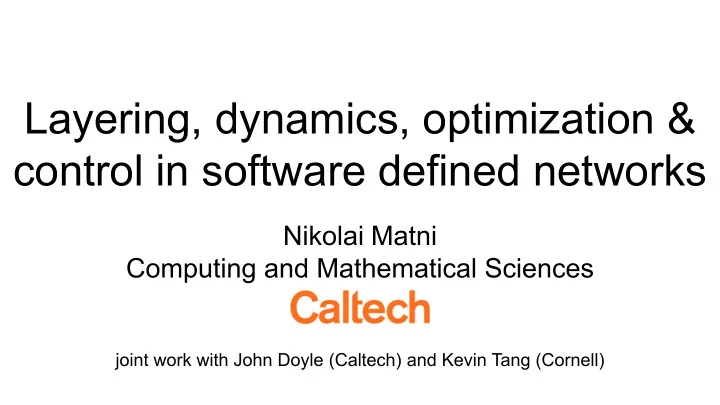

Layering, dynamics, optimization & control in software defined networks Nikolai Matni Computing and Mathematical Sciences joint work with John Doyle (Caltech) and Kevin Tang (Cornell)
Distributed optimal control & software defined networks Nikolai Matni Computing and Mathematical Sciences joint work with John Doyle (Caltech) and Kevin Tang (Cornell)
Control theory Using feedback to mitigate the effects of dynamic uncertainty on a system “open loop” disturbances set-point plant 3
Control theory feedback to close the loop measurements Controller control action Actuators Sensors disturbances set-point plant 4
A familiar example: TCP Feedback: AIMD based on drops, RTT, queue length, etc. Guarantees: converge to NUM optimizing transmission rates converge Only steady state guarantees 5
Stabilizing controllers Controller #1 Controller #2 6
Optimal control theory minimize worst-case amplification control error disturbance action Bounded energy Bounded magnitude 7
Optimal control theory minimize average amplification control error disturbance action white noise 8
Centralized control Can lead to poor performance for large-scale systems One system Global access to measurements Controller Sensors Actuators One Global control controller of inputs Plant control inputs measurements 9
Distributed control C S A P 10
Distributed control C C C C C S A S A S A S A S A convex! P P P P P C C C C S A S A S A S A if control packets P P P P C get priority C C C C S A S A S A S A S A P P P P P C C C C S A S A S A S A P P P P 11
Distributed optimal control in WANs 12
WAN distributed optimal control TE solved using nominal demands real traffic fluctuates around nom rates High Frequency Traffic Control rate deviation queue length L1 S1 13 egress buffer control “ ” fl fl fl ∗ fl fl ∆ fi fl – fl λ
Generalizes FIFO/Smoothing rate deviation queue length egress buffer control ↵ -F Packet loss (%) FIFO Src2 S2 λ λ 20ms Smoothing S1 S3 Src1 Dst1,2 ↵ Average queue length (Mbits) ↵ fi 14 ↵ λ ↵ µ, σ σ § µ ↵ fl fl ® ¥ ↵ ↵ ↵ ↵ ↵ fi λ ↵ ↵ ↵ ↵ λ ↵ ↵ ∗ σ σ ↵ ∗ ↵ fl ↵ fl ↵ fl → → → ↵ – λ ↵ fi ’ τ –
Controller architectures Globally Optimal Delay Free (GOD-F) controller 0 delay comms High Frequency Traffic Control rate deviation queue length 15 egress buffer control
Controller architectures Centralized controller High Frequency Traffic Control rate deviation queue length 16 egress buffer control
Controller architectures Distributed new theory ctrl packets get priority = convex! control control control control High Frequency Traffic Control rate deviation queue length 17 egress buffer control
Controller architectures Decentralized (myopic) non-convex use best guess control control control control High Frequency Traffic Control rate deviation queue length 18 egress buffer control
WAN reflex layer Max link utilization centralized most centralized delay distributed decentralized FIFO (standard) least decentralized delay theory & experiments σ = 5 are consistent! σ = 10 Demand fluctuation std. dev. 19 N. Wu, A. Tang, J.C. Doyle, …, N. Matni, in preparation N. Matni , A. Tang, J.C. Doyle, ACM SIGCOMM Symposium on SDN Research, 2015
A theory of network architecture Can we understand & automate: • deciding where to put functionality? Must model • layering and inter/intra-layer protocol design? dynamics & delay • choosing centralized, distributed or decentralized implementations? 20
Nikolai Matni Select references: • N. Matni & J. C. Doyle, A theory of dynamics, control and optimization in layered architectures, IEEE American Control Conference, 2016 • N. Matni, A. Tang & J. C. Doyle, A case study in network architecture tradeoffs, ACM Symposium on SDN Research (SOSR), 2015 High-frequency traffic control preprint available upon request.
Recommend
More recommend